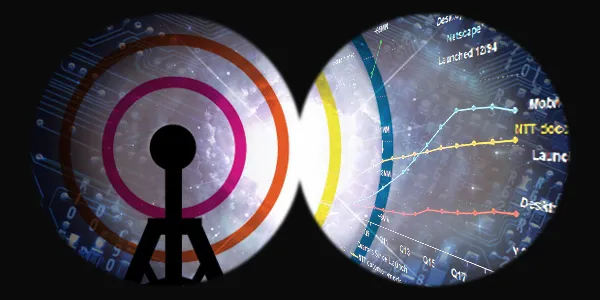2017 outlook: the top 5 technology and business trends for India
TK Srikanth

Thursday December 29, 2016 , 5 min Read
The year 2016 has certainly taken India by storm when you look at developments such as 4G and demonetisation! India Stack and the rise of analytics are trends to watch out for, as outlined in this year-end review piece (see also our earlier article on State of the Net: challenges and opportunities for telcos in India.)

Trend #5: Massive 4G deployment by telcos
The spectrum auction was held in October, but did not receive overwhelming response from the mobile operators. However, the spectrum crunch once touted as the villain for mobile broadband connectivity in the country has eased. With most of the operators having a sizable chunk of spectrum, it is expected that 4G – Long Term Evolution (LTE) technology will be rolled out by all, across the country, thus improving Quality of Service of mobile broadband networks. The grand vision of Digital India can be achieved only if we have a reliable, high capacity mobile broadband infrastructure in the country.
The Telecom Regulatory Authority of India (TRAI) has been actively involved in promoting ‘Public Wi-Fi’ infrastructure as a complement to the cellular mobile network. As we speak, China is much ahead of its 13th Five Year plan’s year 2020 target of 90 percent mobile broadband subscriptions. Our moderate target of 170 million broadband subscription by 2017 seems definitely achievable. With competition and proactive spectrum policies, we should reset the target to reach 250 million by 2017!
Trend #4: More and more data analytics
Pervasiveness of mobiles has resulted in the generation of big data relating to proximity, user context, tastes and preferences, and finally the complete user profile. Analysis of user profiles to target goods and services, advertisements, discount coupons, and promotion programmes have been on the rise. Apart from mobile app providers, telcos are sitting on a huge pile of location-based data that needs exploration and monetisation.
Indian companies are ramping up on data analytics for their services, thanks to the success of Indian unicorns such as Mu Sigma in analytics and decision sciences, and InMobi for its targeted discovery and mobile advertisements platforms. Transportation aggregators such as Ola and Uber are able to provide evidence to carbon emission reduction through their cab sharing services, thanks to huge data collection enabled through their platforms. While concerns over user privacy need to be addressed, using contextual data to provide personalised services is likely to ramp up in 2017.
Trend #3: More unicorns in platform space
With 10 Indian startups attaining the unicorn status with more than a billion dollar valuation, do we expect any additions to this list? Of the 10 in the list, seven of them provide B2C IT-enabled platforms in industry verticals such as transportation, e-commerce and finance. Thanks to modularisation of software components, these startups have been able to deploy their platforms quickly without much upfront investment.
These platforms reduce market inefficiencies, enable better use of under-used resources, reduce information asymmetry and enable disintermediation. Such platforms are characterised by scale economies and network effects. India, with its multitudes of problems and inefficiencies, coupled with a potentially huge user base, provides a grand field for experimentation of these platforms. Can Bengaluru improve its ranking, currently at 15th in the last Compass Report on startup ecosystems in the world? Will Big Basket, Grofers, Pepperfry or Practo join the unicorn club?

Trend #2: Security at an all-time high!
In the digital world, nothing takes precedence over security. Information security encompasses personal, corporates, communities, governments and nations. Though technology solutions such as Rivest-Shamir-Adleman (RSA) public key cryptography systems have been in existence since the 1970s, secure systems continue to face daunting challenges.
Traditional online authentication using username/password pairs have not been found to be adequate in countering cyber-attacks. Moreover, they are cumbersome and are not user-friendly. As a result, there have been increased efforts to find alternatives to username/passwords that can ensure security for online transactions while not compromising the privacy of individuals.
Biometric identification and security such as our own Aadhaar based systems are fast becoming one of the possible ways to provide an easy identification and authentication mechanism. There are forums such as Fast Identity Online (FIDO) alliance that are promoting simplified yet powerful password-less authentication mechanisms and standards.
The challenge for information security has always been the trade-offs between user-friendliness and processing overhead versus desired level of security. We will see simplified yet secure technologies, standards and protocols getting developed and deployed for online commerce, payment systems and even messaging.
Trend #1: India Stack to gain momentum
After a successful deployment of the digital identification system in the form of Aadhaar, a set of government agencies, entrepreneurs, software and hardware companies have been working on India Stack. The stack is a set of Application Programme Interface (APIs) that allows governments, businesses, startups and developers to utilise a unique digital infrastructure; this can help solve India’s hard problems towards presence-less, paperless, and cashless service delivery.
Projects such as electronic Know Your Customer (eKYC) process deployed by Unique Identification Authority of India (UIDAI); Unified Payment Interface (UPI) launched by National Payment Corporation of India (NPCI) that enable digital money transfer; Digital Locker facility for secure issuing and verification of digital documents and certificated initiated by National e-Governance Division (NeGD) of the Government of India, are based on the India Stack framework and philosophy. With organisations such as iSpirit backing it up, it is likely that we see more interest from the developer community, the IT product and platform companies to use the four layers of India Stack for large scale deployment of their products and services.
(This article is authored by Dr. V. Sridhar and Dr. T.K. Srikanth; both Professors at International Institute of Information Technology-Bangalore. Views are personal.)
Come and listen to the experts on the above topics by registering at Mobile India 2017 on 7th January 2017 (Saturday) at the Chancery Pavillion, Residency Road, Bengaluru.










